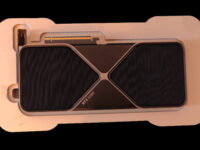
The launch of the Radeon RX 9070 series comes at a pivotal moment for AMD. Following RDNA 3’s underwhelming performance, the RDNA 4 lineup carries the hopes of mainstream PC gamers. NVIDIA’s RTX 40 and 50 series pricing highlights the consequences of a near-monopoly, making AMD’s return to competitiveness critical. While AMD’s GPU market share has dwindled over the past five years, the RX 9070 series presents an opportunity to reclaim lost ground.
| Specs | AMD RX 9070 XT | AMD RX 9070 | NVIDIA RTX 4070 Super | NVIDIA RTX 4070 Ti | NVIDIA RTX 5070 Ti |
|---|---|---|---|---|---|
| Architecture | RDNA 4 | RDNA 4 | Ada Lovelace | Ada Lovelace | Blackwell |
| CUs/SMs | 64 | 56 | 56 | 60 | 70 |
| Shaders/Cores | 4,096 | 3,584 | 7,168 | 7,680 | 8,960 |
| RT Cores | 64 | 56 | 56 | 60 | 70 |
| AI/Tensor Cores | 128 | 112 | 224 | 240 | 280 |
| Base Clock | 2,400 MHz | 2,070 MHz | 1,980 MHz | 2,310 MHz | 2,300 MHz |
| Boost Clock | Up to 2,970 MHz | Up to 2,520 MHz | Up to 2,475 MHz | Up to 2,610 MHz | Up to 2,452 MHz |
| Peak FP32 TP | Up to 48.7 TFLOPS | Up to 36.1 TFLOPS | 35.5 TFLOPS | 40.1 TFLOPS | 43.9 TFLOPS |
| Memory Size | 16 GB | 16 GB | 16 GB | 12 GB | 16 GB |
| LLC Cache | 64 MB L3 | 64MB L3 | 48 MB L2 | 48 MB L2 | 64 MB L2 |
| Memory Type | GDDR6 | GDDR6 | GDDR6X | GDDR6X | GDDR7 |
| Memory Clock | 20 Gbps | 20 Gbps | 21 Gbps | 21 Gbps | 28 Gbps |
| Memory Bus | 256-bit | 256-bit | 256-bit | 192-bit | 256-bit |
| Memory Bandwidth | 640 GB/s | 640 GB/s | 672 GB/s | 504 GB/s | 896 GB/s |
| Total Board Power (TBP) | 304W | 220W | 220W | 285W | 300W |
| Launch Price | $599 | $549 | $599 | $799 | $749 |
The Radeon RX 9070 GPUs feature similar shader capabilities as their GeForce RTX counterparts. However, memory bandwidth is where NVIDIA holds a clear edge.
- The RTX 5070 Ti features faster GDDR7 memory, while the RX 9070 relies on GDDR6.
- Both GPUs have a 256-bit memory bus, but this results in a significant bandwidth gap: 896 GB/s vs. 640 GB/s.

The Radeon RX 9070 is lean on power with a TBP of 220W, while the RX 9070 XT can sip up to 304W. AMD has priced the RDNA 4 aggressively, with an MSRP of $549 for the 9070 and $599 for the XT. In comparison, the GeForce RTX 5070 Ti starts at $749, while the RTX 5070 will retail at $549.
AMD RX 9070 vs. NVIDIA RTX 5070 Ti: 1440p Benchmarks
In rasterized 1440p gaming, the Radeon RX 9070 beats the GeForce RTX 5070 Ti in 4 out of the 9 games tested. The RTX 5070 Ti wins 5, with three decisive wins (+15% or higher lead).



The Radeon RX 9070 delivers potent performance in Avowed, Hogwarts Legacy, and Spider-Man 2, beating the RTX 5070 Ti by 5-10% or more.


Cyberpunk 2077 and Alan Wake 2 exhibit similar frame rates on the two GPUs, at least without ray or path tracing.


Space Marine 2, Black Myth: Wukong, and Kingdom Come: Deliverance 2 favor the GeForce RTX 5070 Ti, beating the RX 9070 by up to 20% or more.


AMD RX 9070 vs. NVIDIA RTX 5070 Ti: 4K Benchmarks
The Radeon RX 9070 one-ups its pricier rival in most games at 4K. However, due to the RTX 5070 Ti’s considerably higher memory bandwidth, the performance deltas shrink to under 10% in Radeon-favored titles like Hogwarts Legacy, Avowed, and Spider-Man 2.






The GeForce RTX 5070 Ti is significantly faster in Space Marine 2, Black Myth: Wukong, and Kingdom Come: Deliverance 2, leading the RX 9070 by up to 20% or more.



AMD RX 9070 vs. NVIDIA RTX 5070 Ti: Ray Tracing Benchmarks
Ray tracing has been Radeon’s bane since its popularization with the RTX 20 Super lineup. With the RDNA 4 architecture, AMD rises up to the RTX challenge, even beating pricier GeForce rivals in multiple cases.

The Radeon RX 9070 registers wins in Hogwarts Legacy, Indiana Jones and the Great Circle, Spider-Man 2, and Avowed with ray tracing cranked to the highest. It beats the RTX 5070 Ti by satisfactory margins in each of these titles.



However, as seen earlier, the deficit shrinks at 4K as the RTX 5070 Ti flexes its superior bandwidth muscle.


While the Radeon RX 9070 performs admirably in the first four ray tracing titles, outclassing the pricier RTX 5070 Ti, it’s vastly sluggish in the last four, trailing even the last-generation RTX 4070 Ti. These games include Cyberpunk 2077, Alan Wake 2, Plague Tale: Requiem, and Star Wars: Outlaws.




But let’s not forget. These are all GeForce partner titles, and a 10-20% deficit between a $549 and $749 GPU is fairly acceptable.
AMD RX 9070 vs. NVIDIA RTX 5070 Ti: Path Tracing Benchmarks
We tested the RX 9070 in two path-traced games and found mixed results.

Cyberpunk 2077 runs significantly faster on the RTX 5070 Ti due to its reliance on RTXDI (NVIDIA’s ReSTIR-based dynamic lighting). You can read more about it here.

Indiana Jones and the Great Circle is 30% faster on the RTX 5070 Ti due to its more traditional path tracing approach. This suggests that AMD’s path tracing performance is title-dependent and may improve with developer partnerships.
AMD Radeon RX 9070: Power & Temps
Afterburner reported an average power consumption of 230-240W across most benchmarks. That’s slightly than the card’s 220W power budget. The peak path tracing power draw was 340W. These values may not be completely accurate.
The ASUS TUF gaming variant maintained temperatures of less than 55C, with a peak recorded value of under 60C. Given that the card has a massive triple-fan, triple-slot heatsink, this is just what we were hoping for.
Conclusion: A Worthy Midrange Contender
The RX 9070 delivers smashing value at its $549 price point, beating the more expensive RTX 5070 Ti ($749) in most cases. It offers comparable ray tracing performance at lower power budget.





